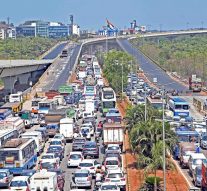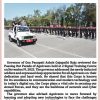Goa is abuzz with excitement as vintage bike and car owners, users, collectors and fans are decking […]

Traffic Jams Choke Goa
Uncategorized November 21, 2025By Praveena Sharma
The tiny State’s charming palm-lined narrow roads are weighed in by heavy traffic as its vehicle population at around 13.23 lakh threatens to surpass its 15.96 lakh population and create havoc
As Goa headed into International Film Festival of India (IFFI) – a la Cannes Films Festival – politician Utpal Parrikar was a worried man. Soon, as IFFI delegates would stream in, Panaji’s arterial roads would get clogged with traffic.
To unclog them, vehicles would be shunted to narrow interior roads running through residential and market areas, which were already grappling with choking traffic and dented roads.
People dwelling in these localities were dreading the onslaught of traffic woes the film festival would bring along. It didn’t help much that Chief Minister Pramod Sawant had summarily dismissed traffic concerns raised by a journalist at a curtain-raiser presser.
“Tomorrow, (November 20), (when) IFFI starts and all main roads will be closed for traffic. Then, automatically, all traffic going to Miramar and Kala Academy will be diverted from there to here (Taleigao). We will have face traffic jams on our roads because of the declining quality of road,” said a harried Parrikar.
His repeated appeal to various authorities has fallen on deaf ears. In a last-ditch effort, Parrikar – son of late Chief Minister Manohar Parrikar – decided to appeal to public works department (PWD) minister through the media.
His grouse was that no amount of repair was mending their roads. Within months, craters grow back on them, with no accountability sought from contractors.
This, even as Goa’s vehicle population zooms up to 13.23 lakh, as stated in the Goa Road Safety Policy, 2025. The Economic Survey for 2024-25 projected the State’s population for current year to be around 15.96 lakh. What this mean is that for every 1.2 persons, there is one car.
The same document mentions allocation of “a total road length of 62.62 kms under PMGSY-III”. Based in this, the State Level Standing Committee (SLSC) has prepared proposals for 11 road and three bridges at an estimated cost of Rs126 crore.
According to the Economic Survey, the government has spent around Rs 1531 crore for hot mixing around 2676 kms of roads between 2019-20 and 2023-24. Till December 31 last year, an additional Rs223 crore was pumped into hot mixing 337 km of roads.
Despite the over Rs1,700-crore spent over the 7-8 years on smoothing the road surfaces across Goa, drives or rides on most stretches of Goan roads remain bumpy.
And, the problem of rising vehicles on the roads is only compounding by the year. Number of driving licenses being issued by Road Transport Office (RTO) has also shot up. For the last fiscal, 23,337 driving licenses were issued till December 31, 2024.
Even as vehicle numbers climb up, the development of transport infrastructure is lagging. Prashant Joshi, managing director of Goa Hyundai Motor Pvt Ltd, believes the recent phenomenon of rising vehicle numbers is not unique to Goa in the country.
He said the primary factor for the robust growth in vehicle numbers was inadequate public transport, which compelled people in Goa to acquire private vehicles to remain mobile.
“Lack of public transport is a major factor for high vehicle density in Goa. There are very few public bus services, and they stop after 8 pm. If somebody has to travel at night, there’s no public transport. Moreover, Goa also has taxi issues. So, people can’t rely on taxis also,” he summarised Goa’s traffic woes.
Parrikar agreed with Joshi. But for him, there was a toss-up between giving in to urbanisation by enhancing public transport and retaining the old character of Goa that was seeped in its village life.
“It’s a catch-22 situation. Once you decide to create more transport infrastructure, it will trigger urbanisation and concretisation of cities and villages, resulting in Goa’s old character of villages connected by small roads being lost. Then, people are aspirational and want to buy vehicles. This means we must build more roads. It’s a tricky situation,” he said.
Explaining why infrastructure has not kept pace with explosion in number of vehicles on the road, Joshi said the former was plagued with several procedural hassles, the biggest being acquiring land for road projects.
“Anywhere around the world, almost always, infrastructure development falls behind vehicle growth. They cannot keep apace with each other. You cannot rush through infrastructure development. It is time consuming because of procedural issue like land acquisition and all that,” he said.
Joshi, who has been the president of Goa Automobile Dealers Association (GADA) and is one of car dealers in the State, said there was a slump in car sales before goods and services tax (GST) rates on vehicles were rationalised in August.
After the new GST rates came into effect (September 22), his car sales jumped 10-15%. He attributes it to festive sales too.
“Average four-wheeler sale for us was in the range of 1500-1800 cars a month – all car dealers put together. After GST reduction that has gone up to 2800-3000 cars,” he informed.
High vehicle density has another fallout – road fatalities, which has risen in recent years. So much so that the State transport authority has suspended issuance of fresh rent-a-cab licenses since February to control congestion and improve road safety.
Data put out by the department of planning, statistics and evaluation (DPSE) shows there were 2574 road accidents, in which 265 killed and 1164 injured, in in 2024-25. Finland’s capital Helsinki reported zero road fatality till August this year (See Box).
Majority of the vehicles involved in accidents are rented vehicles driven by tourists. This was the reason the State government halted issuing licenses for rent-a-car services early this year. Goa Economic Survey reveals a rapid growth in registrations of “motorcycle for hire” at 44.85% in 2023-24 compared to 2019-20 and around 70% increase in taxi registrations during the same period.
Another significant revelation was that 97.5% of accidents occurred due to rash, negligent and drunken driving.
Parrikar called for better monitoring and regulations for rented vehicles on Goa’s roads. According to him, tourists driving into Goa from outside with their vehicles also need to be policed.
Both Joshi and Parrikar feel since Goa is a tourist destination, it could act as a constraint in effectively controlling drinking and movement of tourist vehicles around the State. They said the government would have to work within those limitations.
“When you talk about Goa, tourism is its backbone. You will have all kinds of tourists. Some tourist will want to drive (in rented cars) but there should be monitoring of drunken and rash driving and enforcement of regulations. They (tourists) should know if they drive under the influence there will be consequences,” he said.
Parrikar suggested, Goa could learn from the USA, and introduce “designated driver” concept, where one person, who is expected to remain sober in a group, is designated as driver. This is done in collaboration with restaurants and pubs. The designated driver gets free non-alcoholic beverages as reward.
Hounded by concerns over Goa’s road safety, the State government came out with Goa Road Safety Policy, 2025 (See Box) that “aims to establish a safe, efficient and technology-driven road transport ecosystem by leveraging automation, artificial intelligence and data analytics”.
Even the Economic Survey, 2024-25 is full of brilliant suggestions (See Box) to improve traffic management and road safety but will they materialise is what needs to be watched.
Ideally, Goa should go for a more sustainable road and traffic management solutions, like Al Baha (see Box) and Helsinki (See Box), which are all about reducing reliance on private vehicles and encouraging wider use of environmentally friendly modes of travel – public transport, cycling and walking.
The question is here is: Will the government want to give up the huge revenue it earns from taxes on private vehicles? Over the years, this revenue has grown several folds. (see Box). It shot up from Rs3 crore in 1987-88 to Rs482 crore in 2023-24. Last fiscal, it was Rs546 crore.
Interestingly, the State allocated just Rs15.48 crore to transport in its annual plan last fiscal.
Goa Road Safety Policy, 2025
In May, the government notified the Goa Road Safety Policy, 2025 to “augment monitoring, compliance and accident prevention”. Its purpose was to create safe roads, and a more efficient and sustainable road transport system.
It will be implemented over the next three years. During this period, an independent lead agency would be established and the State Road Safety Council (SRSC) would monitor the progress of the policy execution.
It aims to achieve enforcement of road safety rules through 100% high security registration plates (HDRP), vehicle location tracking devices (VLTD) and speed governors in every vehicle.
It plans to implement an AI-based traffic management system (ATS) through a public-private-partnership (PPP) model in a phased manner across the State.
To address the issue of rash driving and safety of vehicles, it is looking at establishing automated testing stations (ATS), integrated driver training centre (IDTC) or regional driving training centre (RDTC).
The traffic rules understanding and safety training (TRUST) programme is aimed at improving driver awareness and compliance.
The e-detailed accident report (e-DAR) and integrated road accident database (i-RAD) is expected to help in data-driven accident analysis and inter-departmental coordination among government departments for effective implementation of the policy.
The government will review the impact of the policy after three years and the success in achieving targets set by Supreme Court Committee on Road Safet (SCCoRS) to draw up a new policy for road safety governance.
Can We Become Al Baha?
A tourist destination in Saudi Arabia with lowest traffic congestion in the world
At the face of it, Goa and Al Baha – a popular travel destination in Saudi Arabia – have a lot in common. They are both geographically tiny, thinly populated, and most part of their areas are undulating. But they are diametrically opposed when it comes to traffic congestion.
Goa is fast becoming the State with highest vehicle density in India – almost one vehicle per person – that has brought with it issues of traffic congestion. Conversely, a report by TomTom Traffic Index 2024-25 has adjudged Al Baha as the least congested city in the world, with a congestion level of just 7%.
Its low traffic congestion makes it easy for people to commute within the city. According to TomTom Traffic Index, the average travel time per 10 km within the city is around 11 minutes and 17 seconds and the average speed is 53.2 km per km/h for a 10-km trip.
Al Baha’s municipality area is 370.29 sq km with a population density of around 244.4 people per sq km.
This Saudi Arabian city can keep traffic congestion low because of following reasons:
• Lower population density is one of the reasons for few traffic jams and gridlocks.
• Robust inflow of investment into road construction and maintenance.
• Despite its mountainous terrain, Al Baha has a well-managed road network of around 2,600 km of asphalt road. This also supports its tourism.
• The city has invested on signages, resurfacing of roads and erecting in guardrails to make travel smoother and efficient.
• An interesting aspect of the Al Baha city is, like Goa, it has limited public transport system. A UN‑Habitat transport plan notes that only a small fraction of its residents has good access to the bus network.
Helsinki Had Zero Road Fatality in Last One Year
All it did was lower speed limits, improve cyclist and pedestrian infra and come down hard on violators of traffic rules
In August, Finland’s capital Helsinki reported no deaths due to road accidents since July last year. The Finnish capital achieved this feat through its policy of ‘Vision Zero’ – a road safety plan targeting zero traffic fatality.
Around the same period, Goa reported 265 road fatalities while countrywide, as per Ministry of Road Transport and Highways (MoRTH), the number stood at 1.70 lakh deaths in 2024.
Do we need to take a leaf out of Finland’s traffic management book? What makes their system tick?
If you look closely, it does not require rocket science. Just oodles of political will. Some of the measures taken by Helsinki were lowering speed limits, improving infrastructure for pedestrians and cyclists, and stringent enforcement.
Today, more than half of the Finnish city’s streets have a speed limit of 30km/hour – down from the earlier 50km/hour in many areas. Introduced in 2021, it has been slowly scaled up to cover a wide area.
Redesigning of the streets also helped in reducing fatalities on roads. It involved building safer intersections, elevated crosswalks, improved lighting and separated traffic flows.
Besides Finland, countries like Sweden, Singapore, China (Hangzhou) and UAE (Abu Dhabi and Dubai) are also competent in managing their road traffic. Netherlands is also among countries whose roads are safest in the world.
For Netherlands, it’s simply about maintaining a sustainable transport system and creating cycling and walking infrastructures. In most Indian cities, concepts of footpaths or cycle lanes are non-existent.















